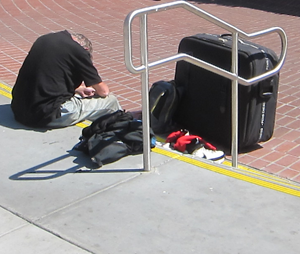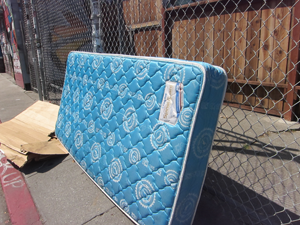In innovative approach, BART outreach focuses on moving homeless people into services
 Armando Sandoval (left) talks with a community member who advocates for helping the homeless population around the 24th St./Mission BART Station Plaza to access services and move into housing.
Armando Sandoval (left) talks with a community member who advocates for helping the homeless population around the 24th St./Mission BART Station Plaza to access services and move into housing.
By MELISSA JORDAN
BART Senior Web Producer
The man leaned against the wall of Powell Station, in ragged clothes, his worn-out shoes behind his head for a pillow.
"Are you doing alright?" Armando Sandoval asked. A nod in reply provided the quiet understanding that the man was, indeed, OK. "Do you need any help?" He shook his head no. He was a regular, one of the many homeless people who look for a safe haven to rest in BART stations, most noticeably those in downtown San Francisco.
There is a delicate balance in dealing with this population, and Sandoval was hired by BART to tread that fine line. His official title is Crisis Intervention Training Coordinator and Community Outreach Liaison, and BART is one of only a few transit agencies in the nation to have a position completely dedicated to such training and outreach, the innovative idea of BART Police Chief Kenton Rainey.
“When I came to BART, I was looking for something proactive that we could do, before problems happened,” Rainey said. “It made a lot of sense to have someone who could train our officers in de-escalating confrontation, and who could work directly with the homeless population, many of whom have issues including mental illness or addiction, where special training is needed.”
Spend any time with Sandoval and you are going to hear the words "perspective," "point of view," and "complex" a lot. He understands that BART riders expect and deserve a safe, clean environment in their stations; they should not have to step over people sleeping on stairs, smell the stench of elevators used as urinals, or worry for their safety. From one perspective, a rider might say, "throw them all out."
From another perspective, it may be that no laws are being broken, that Sandoval is very, very close to getting a homeless person into a shelter; or to go to a mental health clinic or drug treatment program; and maybe, just maybe, turn their life around where they have better options for society than sitting in a BART station or plaza.
SUCCESS STORIES
"There are success stories," said Sandoval, who was hired by BART in a fulltime staff position last year after serving in a consulting capacity since 2012. Previously, Sandoval had worked in the fields of homeless outreach, mental health and addiction recovery for nearly 30 years. Many on the streets are veterans of military service; they are all someone's son or daughter, and it is hard, repetitive work to reach many of them.
"It may be there are some people who are just born to do this work," he said. "For me, it is a calling." - Armando Sandoval
He is not a police officer, although he works within the police structure. His purpose is two-fold -- to help clean up the stations, yes, but also to connect these people when possible with the service providers who may change their lives.
BART Police Sgt. Michael Williamson, who is based in the downtown San Francisco zone, calls Sandoval "incredibly valuable. I believe it's easier for persons who are homeless to speak to Armando, because in most people's minds, the (police) uniform means enforcement - they don't get to see us as peace officers."

Williamson explained that in most cases, a homeless person just passing time in a BART station or plaza, sitting on their own without blocking a throughway or aggressively panhandling, is not committing a crime. Sleeping, as opposed to sitting up alert, is not allowed, however, because under building code regulations BART must be able to quickly evacuate the station in an emergency and a person in a deep sleep or passed out poses a problem for the safety of themselves and others.
BALANCING NEEDS AND RIGHTS
"We are a public facility and unless someone is violating the law, we walk by and check on their welfare," he explained. "If they are blocking free movement we will ask them politely to gather up their belongings and move along. We have to balance the needs of the patrons with the rights of our transient population."
There are a couple of ways that riders who are concerned about the presence of homeless people in BART stations can help, he explained:
* If a person appears sleeping or unconscious and you are worried for their welfare, use the white emergency phone in the station, contact the station agent or call BART Police at 510-464-7000 to come and do a welfare check.
Rider Tip: Program your phone to call BART Police at 510-464-7000
A FOCUS ON PREVENTION
For many, there is shame, Sandoval says, and they may be too proud to accept his offers to help them find a bed or a clinic. This is a sea of humanity, but a highly complex and mixed population with different needs. It's his job to figure it out.
A COMPLEX JURISDICTIONAL SYSTEM

A mattress is on the San Francisco City property side of the alley, and at night gets dragged to the BART plaza side, illustrating some of the jurisdictional challenges.
NOT A MONOLITHIC GROUP
HELP, THEN HARD CHOICES
Don Jackson, a BART PD community service officer for downtown San Francisco, said the CIT training really opened his eyes. "Things we see every day, we realized we weren't REALLY seeing, until we went through the class," he said. One specific tip he learned, he said, was to listen for keywords -- a reference to a mother, or a pet, or a long-ago love, may provide an opening point to draw a person into a lucid conversation. Another reference may set them off. "You have to really listen a lot," he said.
On a walkalong with Sandoval through the stations we saw apparently homeless people of all ages, races and conditions. There are young people who appear to be of college age charging their phones and computers at station outlets, with their backpacks of belongings and a sign asking for money (not illegal in itself). There are frail, elderly people, with bare feet, matted hair, missing teeth. There are the well-dressed.
A FIXTURE IN THE SYSTEM
And there are those like the man whose name is Booker, who longtime staff say has been standing in the Powell BART Station nearly every day since it opened -- 40 years of standing. He does not generally ask for help, drink alcohol, sleep on the ground, hurt anyone, or break any rules. Mostly, he just stands.
"Good morning sir. Why do you do this?," the tagalong asks him. "Isn't it uncomfortable for you? Do you have somewhere else to go?" Sandoval and Jackson have heard all the versions of his story, and there are many. Today, the story is that he is waiting for a backpack, taken 40 years ago, and when the person who took his backpack brings it back to him, he will leave. Today, he stands and waits.
Williamson added: "If we can get help for the people who want it, and it may take several contacts, we will have less calls for service and it reduces the chance that offenders are going to reoffend," Williamson said. "The more people we can help, the safer it is for our riders, our employees and our officers. The better it is for everyone."